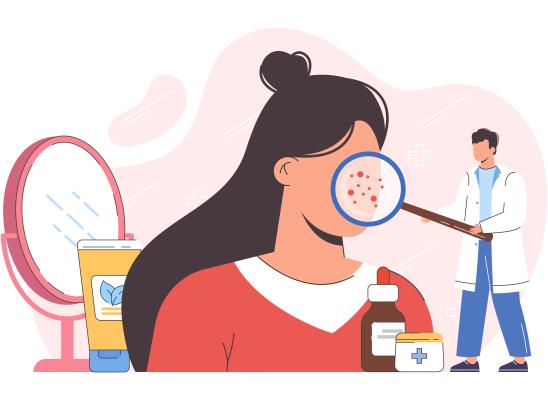The Voice That Permits Picking

Online test
Find out the severity of your symptoms with this free online test
Skin picking is a body-focused repetitive behavior (BFRB) where someone recurrently and compulsively picks at their skin to the point of injury. Research has identified certain characteristics and factors associated with skin picking but it remains not well-understood and difficult to treat. The diagnostic criteria for skin picking disorder include, “the skin picking causes clinically significant distress or impairment in social, occupational, or other important areas of functioning.” What that actually means is highly dependent upon the individual and how they experience their skin picking.
Just why do people pick at their skin? We know that it is more than just picking a blemish. One area that has gotten increased attention is the cognitive processes that drive skin picking. Targeting these driving cognitions is a central focus of treatment interventions such as cognitive behavioral therapy (CBT) and Acceptance and Comittment Therapy (ACT). What is the nature of the thoughts and feelings that seem to trigger and perpetuate the picking behavior and how might a better understanding of them contribute to more effective therapeutic interventions?
The Voice That Permits Picking
A recent study took a closer look at skin picking through the lens of the lived experiences of people living with skin picking. Their research identified three over-arching themes related to skin picking:
- The Voice that Permits Picking: Cognitions Drive Picking and Undermine Resistance (the drive to pick)
- Switching Everything Else Off (the experience of picking)
- I Worry About People Looking and Judging Me: Distress in how Picking is Seen (the consequences of picking)
Their findings suggest that the drive to pick may be driven by thoughts and circumstances that allow picking, and that diminish the will to stop. Within this driving dimension of The Voice That Permits Picking, three sub-themes emerged:
Sub-Theme One: Skin Texture Must Go
Thoughts and attention focused on the skin texture motivated picking. Participants unanimously reported that wanting smooth textured skin was an immediate trigger. Skin damage was viewed as an unintentional, collateral outcome. Some would continue to pick knowing that their skin wouldn’t heal.
Sometimes the picking was triggered by an actual skin blemish and the need to correct it. The area was seen as “not acceptable” or unhygienic and in need of “cleaning”. For others, their picking was related to thoughts about social experiences which “made them more alert to imperfections” and the need to pick. For some, they attributed their thoughts about their skin and picking to experiences with bullying or encouragement to pick.
Participants reported a heightened level of focus that seemed to increase sensory information causing them to “see something else” which further exacerbated the picking. Most also reported that it was difficult to stop once started and that they often needed a finite stopping point or achieve a sense of completion. Some described feeling a sense of satisfaction at “completion”. Satisfaction with completion seems to be related to the idea of incompleteness. Incompleteness creates a persistent inner sense of dissatisfaction with one’s actions and urges to achieve “just right”. It is this sense of tension and need for relief that is thought to drive repetitive behaviors.
This sense of “not just right” is seen frequently in people with obsessive- compulsive disorder (OCD) and not surprisingly, with skin picking disorders.
Sub-Theme Two: ‘Oh Well’ and ‘So What’: Resignation to Picking
This sub-theme focused on the patterns of thinking that contributed to feeling resigned to picking, that it was somehow inevitable, tolerable, or manageable. Some tended to pick more aggressively when they knew that the area they picked would be out of view, suggesting that concealed damage was considered more tolerable. This finding was similar to a study of hair pulling behaviors that found permission-giving thoughts were common and that being able to conceal damaged areas seemed to trigger continued pulling.
Interestingly, when picking was seen as less manageable, such as when there was significant skin damage, the picking behavior decreased.
Sub-theme Three: Picking Because I Can: Permissive Circumstances
This sub-theme focused on the role that opportunity (e.g., free time or free hands) plays in skin picking. Circumstances like boredom or isolation seemed to be a trigger to skin picking.
Skin picking tends to occur in private. Being in social settings tends to deter picking. Being socially connected also seems to mediate emotional regulation. Deficits in emotional regulation that have been suggested as playing a role in skin-picking and other BFRBs include alexithymia, maladaptive emotional reactivity, experiential avoidance, and response inhibition.
Treatment Implications
Understanding what drives the urge to pick is the first step in better addressing those driving factors in treatment. Therapeutic approaches such as Acceptance and Commitment Therapy (ACT), ACT-enhanced (AEBT), CBT and others address both behavioral and cognitive aspects of skin picking and can be effective in reducing the severity and impairment of BFRB behaviors. It is thought that these approaches improve the individual’s emotional regulation skills and, as a result, reduce maladaptive behaviors.
Studies like this one also point to the complex and individual aspects of skin picking and a reminder of how heterogenous skin picking is. It speaks to the need to be mindful of what is meaningful for the individual and tailoring treatment to meet their unique needs. It offers offer hope for more effective, individually focused treatments for those living with skin picking and other BFRBs. Understanding skin picking through the lens of lived experiences serves as a poignant reminder that the experience is uniquely individual and that it touches lives in so many ways.
References
1. Anderson, S., Clarke, V., & Thomas, Z. (2022). The problem with picking: Permittance, escape and shame in problematic skin picking. Psychology and Psychotherapy: Theory, Research and Practice, 96(1), 83-100. https://bpspsychub.onlinelibrary.wiley.com/doi/pdfdirect/10.1111/papt.12427
2. Summerfeldt, L. J., Kloosterman, P. H., Antony, M. M., & Swinson, R. P. (2014). Examining an obsessive-compulsive core dimensions model: Structural validity of harm avoidance and incompleteness. Journal of Obsessive-Compulsive and Related Disorders, 3(2), 83-94. https://www.sciencedirect.com/science/article/abs/pii/S2211364914000104
3. Rehm, I., Nedeljkovic, M., Thomas, A., & Moulding, R. (2015). The Role of Cognitions and Beliefs in Trichotillomania: A Qualitative Study Using Interpretative Phenomenological Analysis. Behaviour Change, 32(4), 209-230. https://www.cambridge.org/core/journals/behaviour-change/article/abs/role-of-cognitions-and-beliefs-in-trichotillomania-a-qualitative-study-using-interpretative-phenomenological-analysis/7B481CE1B2012F20B58565718AA8CF0B
Online test
Find out the severity of your symptoms with this free online test
Start your journey with SkinPick
Take control of your life and find freedom from skin picking through professional therapy and evidence-based behavioral techniques.
Start Now



